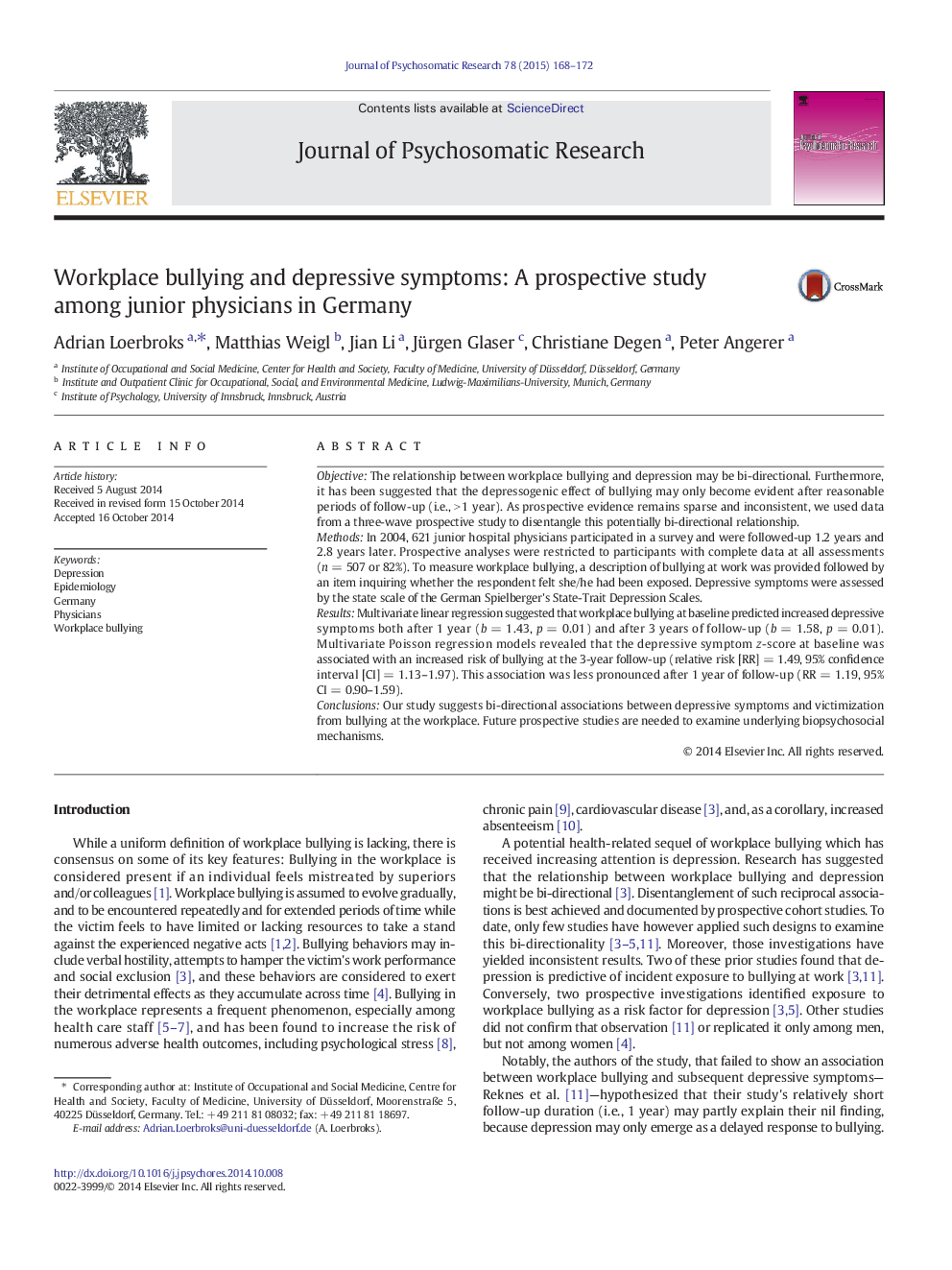Abstract
Objective
The relationship between workplace bullying and depression may be bi-directional. Furthermore, it has been suggested that the depressogenic effect of bullying may only become evident after reasonable periods of follow-up (i.e., > 1 year). As prospective evidence remains sparse and inconsistent, we used data from a three-wave prospective study to disentangle this potentially bi-directional relationship.
Introduction
While a uniform definition of workplace bullying is lacking, there is consensus on some of its key features: Bullying in the workplace is considered present if an individual feels mistreated by superiors and/or colleagues [1]. Workplace bullying is assumed to evolve gradually, and to be encountered repeatedly and for extended periods of time while the victim feels to have limited or lacking resources to take a stand against the experienced negative acts [1] and [2]. Bullying behaviors may include verbal hostility, attempts to hamper the victim's work performance and social exclusion [3], and these behaviors are considered to exert their detrimental effects as they accumulate across time [4]. Bullying in the workplace represents a frequent phenomenon, especially among health care staff [5], [6] and [7], and has been found to increase the risk of numerous adverse health outcomes, including psychological stress [8], chronic pain [9], cardiovascular disease [3], and, as a corollary, increased absenteeism [10].
A potential health-related sequel of workplace bullying which has received increasing attention is depression. Research has suggested that the relationship between workplace bullying and depression might be bi-directional [3]. Disentanglement of such reciprocal associations is best achieved and documented by prospective cohort studies. To date, only few studies have however applied such designs to examine this bi-directionality [3], [4], [5] and [11]. Moreover, those investigations have yielded inconsistent results. Two of these prior studies found that depression is predictive of incident exposure to bullying at work [3] and [11]. Conversely, two prospective investigations identified exposure to workplace bullying as a risk factor for depression [3] and [5]. Other studies did not confirm that observation [11] or replicated it only among men, but not among women [4].
Notably, the authors of the study, that failed to show an association between workplace bullying and subsequent depressive symptoms—Reknes et al. [11]—hypothesized that their study's relatively short follow-up duration (i.e., 1 year) may partly explain their nil finding, because depression may only emerge as a delayed response to bullying. This hypothesis was based on insights from a qualitative study by Niedl, exploring, among others, coping strategies of bullying victims [12]. That investigation drew on the Exit-Voice-Loyalty-Neglect (EVLN) model [13], which conceptualizes how employees may respond to their job dissatisfaction. Responses may include quitting the job (exit), active problem solving by raising the issue (voice), staying at the job while hoping for the problem to be solved some day (loyalty), and reduction of efforts at work or focus of non-work interests (neglect). Niedl observed that coping responses evolved over time: most bullying victims initially engaged into active problem-solving (voice) and some responded with loyalty [12]. As these responses were probably ineffective in coping with victimization from bullying [11], most employees subsequently reduced their commitment to their work (neglect) or quit their job (exit). These specific coping dynamics have been confirmed by other studies [14] and have informed the hypothesis that depression occurs in responses to workplace bullying only with some delay (i.e., more than 1 year), that is, once initial coping strategies (voice and loyalty) have failed, and victims respond with depression and engage into more destructive coping strategies (i.e., neglect and exit) [11].
To improve our understanding of the bullying–depression relationship, it is of interest to provide prospective data to add to the currently limited and inconsistent evidence base. Ideally, such data should allow for the examination of bi-directional associations based on more than two measurement points [11]; in particular, based on the above-mentioned hypothesis, it would be of interest to conduct analyses for different periods of follow-up (i.e., 1 year versus longer periods of time). We therefore set out to determine the prospective associations between workplace bullying and depressive symptoms based on a design with three measurement points which allowed for analyses based on 1 year of follow-up as well as 3 years of follow-up.


